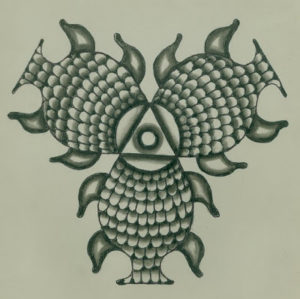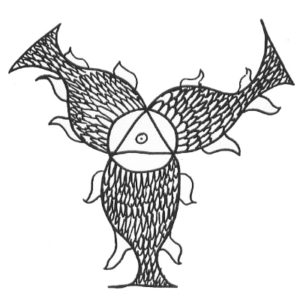If you’ve read Allen Ginsberg, you probably know the image – three fish, one head as a sort of triangular Illuminati eye. Allen saw it in Bodhgaya in 1962, carved into a representation of Buddha’s footprint, itself huge and giant-like, a particular titan-style of respect. It appeared first in his letter to Catholic Worker, May 1967, then his Airplane Dreams, at least the USA 1969 edition, and again in Indian Journals, 1970. Later in 1982, artist-shaman Harry Smith would render a particularly beautiful form of the fishes, and it was used in nearly all of Allen’s Harper Collins publications on the cover as a sort of seal.
I met a barista at a coffee shop in San Francisco who had that tattooed on her arm. She knew it represented “Ginsberg.” She seemed alarmed it had anything to do with Buddha. So what does it mean?
“I once asked Allen about this design, and he told me that it represents the fact that there are so many ‘trios’ across the realm of spiritual belief:
Buddha Dharma Sangha
Brahma Shiva Vishnu
God Jesus Holy Spirit, etc.Even earth, sky, man…”
God Jesus Holy Spirit, etc.Even earth, sky, man.”
7/1/11
The letter from Allen Ginsberg himself, accompanying his drawing, to Catholic Worker, May 1967 said this:
“I saw the three fish one head, carved on insole of naked Buddha Footprint stone at Bodh-Gaya under the Bo-tree. Large – 6 or 10 foot size – feet or soles made of stone are a traditional form of votive marker. Mythologically the 32 signs – stigmata, like—of the Buddha include chakras (magic wheels symbolic of energy) on hands and feet. This is a sort of a fish chakra. So antique artists used to sculpt big feet as symbolic of the illumined man – before Greeks brought in human-face representation of Buddha. They never used to have statues of him – umbrellas, Bo-trees, or feet instead – before Alexander came to India.”
I include two photos of this footprint, which, I have since learned, were almost certainly surreptitiously taken by a friend of mine. Photos are not allowed. This may explain why I haven’t seen other such photos.
However, this is not a common Buddhist image, Dr. Waldemar C. Sailer, author of the website “The World of the Buddha’s Footprint,” in an e-mail to me. So how did it get on Buddha’s footprint, when and to what end?
“Allen Ginsberg’s logo of three fishes with one common head displayed in all his post-India publications, albums, cassettes, exhibition cards etc, which appeared for the first time in his India journals published by City Lights, was a replica of the engraved drawing on the stone floor near the entrance to the tomb of Emperor Jalaluddin Muhammad Akbar. The meaning of this drawing was explained to Ginsberg by Malay Roychoudhury, when they visited Khudabaksh Library at Patna where the same drawing was found on the cover of a Persian book, which was the famous “Deen-E-Ilahi” written by the Emperor, a treatise in which the Emperor had aspired to combine the tenets of Islam, Buddhism and Hinduism. Christianity had not entered the kingdom till then.”
“Hungryalist Influence on Allen Ginsberg”
Triadic & Alo Mitra
The Hugryalists were an East India bohemian poet group coterminous with the Beats. Though I don’t particularly doubt that Malay Roychoudry explained this to Allen, for whatever reason Ginsberg never gave this explanation, let alone remembered it. I wrote Roychoudry directly, who is now 80, and he confirmed his version, including personally seeing its presence in Akbar’s tomb.
Citing this same story, Annabel Teh Gallop, Head Curator for Indonesian and Malay in the department of the South and Southeast Asia section at the British Library, London, writes in a particularly well-researched 2-part article “Three fish with one head,” (December 5, 2019) in The British Library’s Asian and African Studies Blog:
“However, these references to the motif on the floor of Akbar’s mausoleum and on the book binding appear just as elusive as the Buddha footprint at Bodh Gaya, for no corroborative documentation can be found. “
I also found this true, inquiring by e-mail at Khudabaksh Library at Patna and also asking Team India Heritage Walks. ”Agra walk leader” Jitendra Kumar, whose walk includes Akbar’s tomb, wrote back:
“No, I haven’t seen it there. There are many drawings and paintings on his tomb but I don’t think this sketch is there….”
Looks like I have to go myself. Wish me luck.
Annabel Gallop continues:
“The earliest known manifestation of the three-fish-one-head symbol is in ancient Egypt, where it was a familiar motif on ceramic dishes from the New Kingdom period between the 16th to 11th centuries BCE. Representing the tilapia fish and found together with depictions of the lotus, it is associated with the Goddess Hathor. ”
An image from the article shows an Egyptian bowl. Also, another image from a 13th Century South Indian fort wall predates Akbar.
Gallop goes on to finish:
“In short…, the motif of ‘three fish with one head’, which may have originated in ancient Egypt, appears to have so been universally appreciated as such a perfect graphical manifestation of threefold unity that at certain times and in certain places, it has been appropriated by almost every great world religion – Christianity, Buddhism, Hinduism and Islam – yet without ever having evolved into a recognized essential component of the respective religious iconography.”
The main question – since the image is not common in Buddhism, is: how and when does it wind up on Buddha’s footprint? It is not a recurrent image in either Buddha’s footprint or Buddhist imagery at any time. Is it Emperor Akbar, who, as the story goes, was declaring some sort of peace-making with Buddhism and Hinduism? But Gallop’s article indicates that the Egyptian and Indian motif predate Akbar, and, as this scholar, points out, getting an image of Akbar’s use of it eludes even her.
We may never know.
–Marc Olmsted
Essays




In the end, it doesn’t matter to me where it came from. I love that AG picked it up and used it to make a statement about his buddhism. As human as he was Ginsberg shaped my intellectual and cultural and sprirtual life through his endles and tireless work. Thank you for this article.
You know that the most practical car you can consider for driving around the big city is the Kia Picanto. Personally, I would rent such a car in Abu Dhabi https://renty.ae/cars/kia-picanto I advise you to look at the prices and characteristics of this vehicle on the website Renty.